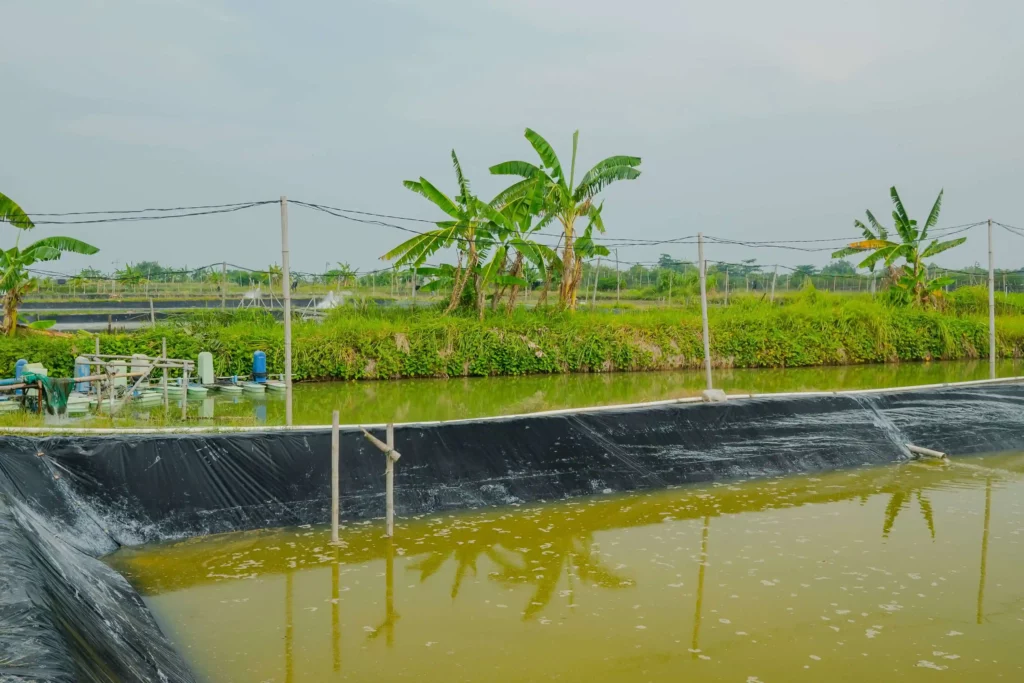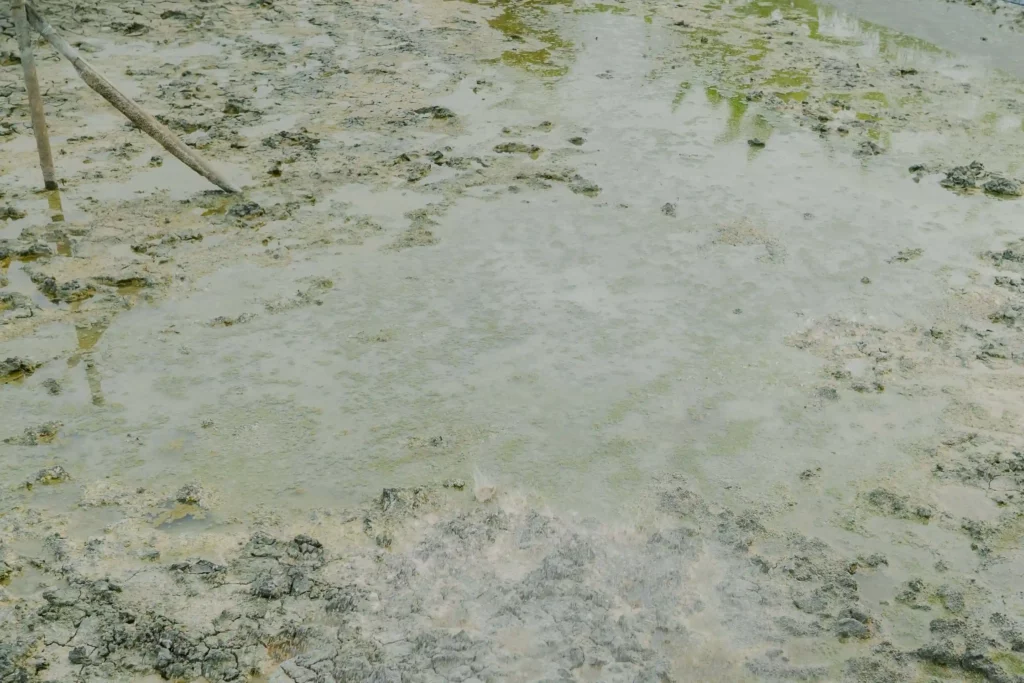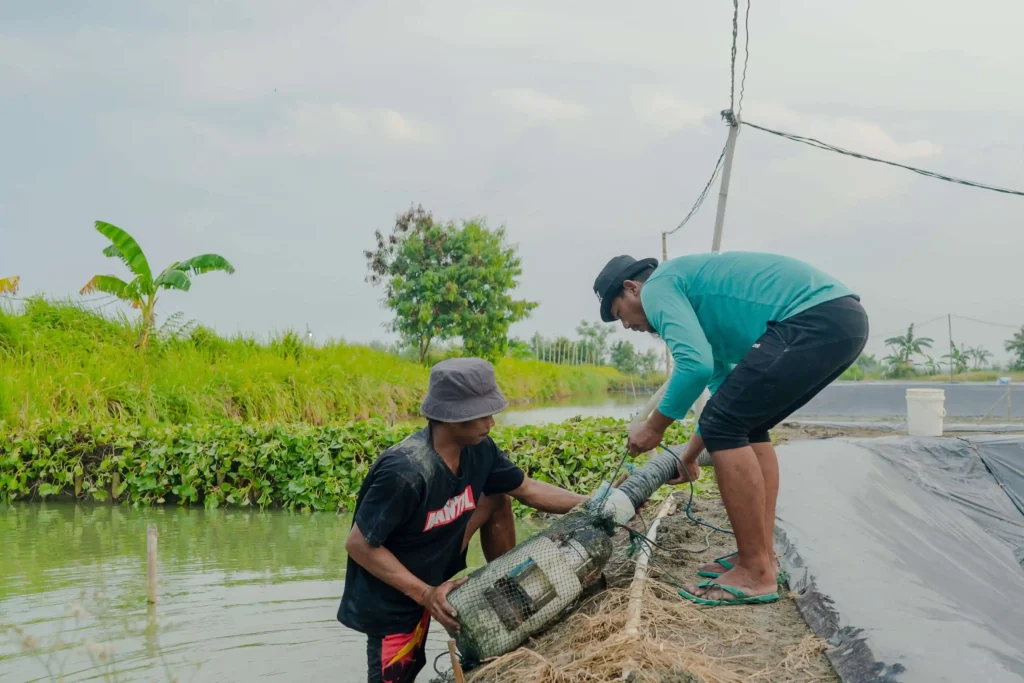Artikel Ini Telah Direview Oleh:

Eko Afriantoro
Praktisi Budidaya Udang
When the shrimp pond water smells, this condition is a warning to the farmers that the pond water quality is poor. Total organic matter level or Total Organic Matter (TOM) also worsened because there were many dead and decaying organisms at the bottom of the pond or pond. The organisms in question are, for example, bacteria and plankton that die and settle.
The decline in water quality is very dangerous for the health of the shrimp and has the potential to inhibit its growth, so it will be difficult for farmers to get maximum yields. Therefore, the following is a description of the characteristics of stinky shrimp ponds, their causes, and how to overcome them.
Characteristics of Stinky Shrimp Ponds

The smell of an unpleasant odor from a shrimp pond or pond is a sign of a chemical imbalance or deposition of waste that can threaten the ecosystem in the pond. Some of the usual unpleasant odors smell, for example, like the smell of rot, the smell of sewage, or the smell of rotten eggs.
Originally the stench came from the bottom of the pond. But as the temperature increases, the aroma will mix with the water layer until it evaporates. The stench comes from deposits of organic matter, such as leftover feed or dead bacteria and sedimentation from wastewater treatment which is exposed to sunlight and creates ammonia gas, which is where the bad smell comes from.
Rotting valves can also create a foul odor if not cleaned immediately. The smell of rotten eggs comes from pond bottom sediment which is a signal of anaerobic occurrence or the presence of hydrogen sulfide (H2S) waste products mixed with carbon dioxide at low pond oxygen levels.
The ideal level of H2S in shrimp ponds is 0. When this number is higher or more than 0, it has the potential to damage the gills of the shrimp, causing pond biota to become easily stressed to the point of death. Other impacts on pond biota that are exposed to H2S at medium levels and for a long enough duration will slow down the growth of pond biota, decrease their appetite, pond biota are more easily exposed to bacteria and disease as well as a high mortality rate. Therefore, it is not surprising that when you clean the bottom of the pond which is full of mud, you will smell a bad smell or the smell of rotten eggs.
Causes of Stinky Shrimp Pond Water

There are 5 causes of smelly shrimp pond water, including the growth of abnormal amounts of algae, mud or dirt at the bottom of the pond, low aeration, poor filter system, and organic matter such as dead fish or aquatic plants. The following describes each cause:
1. Blooming Algae
The development of algae which is quite rapid is in line with the rapid death of algae, so that if algae are born and grow in large quantities in a short time, then in that short time all the algae will die en masse.
However, if you pay close attention, when the algae is created and grows, its presence has disturbed the balance of the pond ecosystem. Pond biota will compete with algae to get oxygen, so when the pond biota experience hypoxia or lack of oxygen it will cause death and the carcasses will settle to the bottom of the pond. It is these deposits that create the stench.
2. Buildup of Dirt and Mud
Actually, at some level the mud does not interfere with the quality of pond water. The sludge comes from shrimp waste, sedimented feed residue, dead and decaying plankton or bacteria at the bottom of the pond, and leaves that fall from the trees above the pond will also settle to the bottom and become mud through a chemical process.
Indirectly, this condition means that the sludge contains a lot of organic matter. Its presence needs to get the attention and control of the Shooter. This is because, in large quantities, silt can interfere with water quality because it has a high level of acidity and reduces dissolved oxygen levels in the water.
These organic wastes will mix with pool water and sunlight, then through a chemical process will create ammonia and produce a rotten smell like rotten eggs. Not all mud can harm the pond ecosystem, only black mud and a thick texture that you need to pay attention to.
3. The Process of Decomposing Proteins and Other Compounds
The process of breaking down proteins and other chemical compounds in the pond will be disrupted if you don't use the correct and proper aeration system. The aeration system delivers oxygen in large quantities and facilitates water circulation so that it can avoid the accumulation of organic waste or certain substances.
When water detects the presence of certain proteins, enzymes will work to break down these proteins into other compounds such as sulfur and ammonia. Nevertheless, under certain conditions protein can also be decomposed by bacteria. Ammonia or bacteria is what makes pool water smell bad.
Not to mention if the water lacks oxygen levels, there are very few enzymes that are able to break down waste or organic matter. If this happens, organic waste will mix with carbon dioxide when oxygen levels decrease. The impact of hydrogen sulfide compounds (H2S) will be higher, in other words, the level of acid will also increase.
4. Bad Filter System
The use of a bad filter system also exacerbates the condition of the pond ecosystem, causing a foul odor. If you don't use a filter or are careless in choosing a filter system, then the organic waste management is not optimal. These wastes will actually accumulate and trigger toxins for pond biota and a bad smell.
5. Organic Decay
The last cause of smelly shrimp pond water is the decomposition of waste or organic matter that is allowed to settle for a long time at the bottom of the pond. Apart from emitting a foul odor, decomposing organic waste that is left at the bottom of the pond will create toxic gases which can suck up oxygen and cause death.
How to Overcome Smelly Shrimp Pond Water

After knowing the causes of shrimp pond water becoming smelly, here's how to solve the problem of shrimp farming.
1. Controls and Eliminates Algae
Even though algae has a positive impact on the pond ecosystem, if the amount is not controlled it will have a negative impact on the life of the pond ecosystem. Therefore, you need to control and clean the pond from algae when there are a lot of them.
2. Cleaning the pond from sludge and sewage
When there is enough mud in the pond, it must be cleaned immediately to avoid bad smells and harmful substances for shrimp. For small ponds, farmers can clean it using a pond net to remove silt and then clean up the remaining dirt using a pond liner.
As for large ponds, you can use a vacuum (siphon technique) and special products to break down silt. However, it should be underlined that the siphon technique or suctioning of mud from the bottom of the pond can only be done in shrimp farming that uses intensive techniques, while extensive cultivation is not quite right considering the bottom of the pond is made of soil.
Another alternative way to clean large ponds is to recirculate or change the water regularly with the following phases:
- Doc <30 days water change 10% every 3 days
- Doc 31-60 days water change 30% every 6 days
- Doc 61 – 90 days water change 40% % every 8 days
- Doc > 90 days of water change 20% % every 4 days
Then after recirculating, farmers can grow plankton to restore water quality. It is recommended to fertilize plankton at the bottom of the pond at a dose of 1,500-2,000 kg/ha.
3. Designing Additional Aeration Systems
Aeration has a function to manage water quality so that the water does not smell and can help shrimp growth. In addition, the use of aeration also helps increase dissolved oxygen levels and break down other gases contained in the water.
In some cases, the use of standard aeration alone is not sufficient. You can add other aeration systems such as using waterfalls or fountains. However, the use of additional equipment certainly has the potential to increase operational costs, especially electricity costs. The solution to solving this problem is that you can use a solar powered fountain in a small pond.
4. Utilize a Filtration System
Furthermore, to maximize the performance of the aeration system, you are advised to have a special filtration system, both an artificial system and a natural system. Artificial filtration systems in the form of special filter devices can be found in aquaculture equipment stores or fish shops. Meanwhile, its natural filtration system can use varieties to increase the amount of good bacteria in the pond. These good bacteria help eliminate odors in shrimp ponds by breaking down substances in waste such as ammonia.
5. Utilizing Good Bacteria
The last way to deal with smelly shrimp pond water is to utilize good bacteria such as nitrite and nitrate bacteria through the nitrification process. The nitrification process is a step to oxidize ammonia compounds by good bacteria so that they turn into nitrites or nitrates. This helps break down organic matter and sludge so it can suppress or neutralize odor-causing compounds, such as ammonia and H2S.
In order for the nitrification process to be successful, it needs to be assisted by the pH level of the water, temperature, dissolved oxygen levels, the speed at which the ammonia gas evaporates from the surface of the pond into the air, and the ammonia level itself. Even so, what you need to pay attention to is that if the levels of nitrite or nitrate exceed the maximum limit, it can endanger the survival of the shrimp. Therefore, set the levels of nitrite and nitrate in the pond more or less than 0.5 mg/L.
Need Help for Shrimp Cultivation Business?
Need Help Regarding Shrimp Cultivation Business?
Fill in your personal data in the following form. Our team will immediately contact you via the number cellphone attached. Make sure the data entered is correct.
Have the causes and solutions for the smelly shrimp pond water above answered your shrimp farming problems? If not or if you still have many questions about shrimp farming, then find the answers at eFarm.
Through its superior features namely Cultivation Consultation, Farmers have the opportunity to consult directly with aquaculture and shrimp farming experts directly for free.
Now, you don't need to worry and bother when you find shrimp farming problems. Just do it Cultivation Consultation in eFarm!

Eko Afriantoro - Praktisi Budidaya Udang
Eko berpengalaman sebagai praktisi budidaya udang sejak tahun 2013 yang kini menjadi Farm Lead Research & Development (R&D) Shrimp eFishery.
Questions About How to Overcome Smelly Shrimp Pond Water
There are 5 causes of smelly shrimp pond water, including too much algae, accumulation of sewage and sludge, disruption of the process of breaking down proteins in the water, poor filtration systems and organic decay.
To eliminate odors in shrimp ponds, farmers must control and reduce the amount of algae in ponds, routinely clean ponds from sewage and sludge and design appropriate aeration and filtration systems.
- https://biotagroup.id/3-cara-budidaya-udang-tambak-untuk-pemula/
- https://gdmorganic.com/bau-amonia-pada-kolam-ikan/
- https://mesin.uma.ac.id/2022/02/21/cara-mengatasi-air-tambak-bau-perawatan-aman-mudah/
- https://mesin.uma.ac.id/2022/02/22/langkah-langkah-mengatasi-mencegah-air-tambak-bau-perawatan-aman-buat-ikan/
- https://nanobubble.id/blog/parameter-kualitas-air-tambak
- http://trobosaqua.com/detail-berita/2014/11/15/13/5318/waspadai-penumpukan-bahan-organik-tambak
- http://trobosaqua.com/detail-berita/2020/07/15/13/13225/agus-somamihardja-bijak-mengelola-limbah-tambak-udang
- https://www.suarantb.com/2019/10/15/bau-amis-tambak-udang-dusun-lengkukun-disikapi-dinas-lh-klu/
